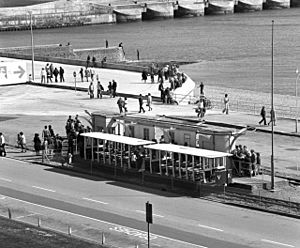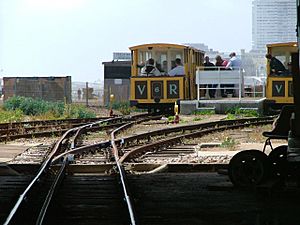Volk's Electric Railway facts for kids
Quick facts for kids Volk's Electric Railway |
|
|---|---|

The old Aquarium station (subsequently rebuilt)
|
|
| Overview | |
| Owner | City of Brighton and Hove |
| Locale | Brighton, East Sussex, United Kingdom |
| Service | |
| Operator(s) | City of Brighton and Hove |
| History | |
| Opened | 3 August 1883 |
| Technical | |
| Line length | 1.02 miles (1.64 km) after line shortened in 1990 |
| Track gauge | 2 ft 8 1⁄2 in (825 mm) |
| Old gauge | 2 ft (610 mm) (1883-1884) |
| Electrification | 110 V DC by inside off-set third rail |
The Volk's Electric Railway (VER) is a special train line in Brighton, England. It runs along the beautiful seafront. It was built by Magnus Volk and opened in August 1883. This makes it the oldest electric railway still running in the world! While it wasn't the very first electric railway ever built, the older ones are no longer in use.
Today, the railway is a fun tourist attraction along the coast. It usually closes during the colder winter months. Sometimes, it might also stop running because of bad weather or if it needs repairs.
Contents
History of the Railway
Magnus Volk's Idea
On August 3, 1883, Magnus Volk opened his electric railway. It was about 1⁄4 mile (402 m) long. The first part ran between Swimming Arch and the Chain Pier. The small train car got its power from the two rails it ran on. The electricity was 50 volts DC.
On April 4, 1884, the line got longer. It stretched another 1⁄2 mile (0.8 km) past the Chain Pier to a place called Paston Place. At this time, the tracks were also made wider. The electricity was increased to 160 volts DC. In 1886, a special third rail was added next to the tracks to give power. This helped stop electricity from leaking away.
Magnus Volk also built another unusual railway in 1896. It was called the Brighton and Rottingdean Seashore Electric Railway. This one closed in 1901. After it closed, Volk's original electric railway was made even longer. It went from Paston Place (now called Halfway) to Black Rock on February 21, 1901.
In 1930, the railway line was made shorter at the western end. It moved 200 yards (183 m) back from the Palace Pier to its current end, which is still called Aquarium. In 1935, a swimming pool called a lido was built at Black Rock. The railway line was shortened again by about 200 yards (183 m) to make space for it. A new Black Rock station opened in 1937 at the end of this shorter line.
Brighton City Takes Over
In April 1940, the city of Brighton took over the railway. On July 2, 1940, the line had to close because of preparations for World War II.
After the war, starting in 1947, the city rebuilt the line. They used stronger rails for the tracks. At Black Rock, a new station was built because the old 1937 building was damaged during the war. The railway reopened for passengers in 1948.
The railway stopped running in winter from 1954 onwards. However, it did open for a short time in the winter of 1980. Many people came to see the Athina B, a ship that had crashed near the Palace Pier. In 1964, the railway started using two train cars together.
In 1995, the Volk's Electric Railway Association was created. This group helps the railway's operator, Brighton & Hove City Council. They help promote and run the railway. In 2003, the Volks Railway Institute of Science and Technology was formed. It teaches schools and groups about the science behind this old Victorian railway.
In the late 1990s, the Black Rock end of the line was shortened again. This was to allow a large storm water storage project to be built. The 1948 station was taken down and a new station was built. It opened in 1998 and shares a building with a water pumping station.
Help from Lottery Funding
In 2014, the railway received a big grant of £1.6 million from the Heritage Lottery Fund. This money had to be spent by March 2017. The funding helped with many things:
- Building a new visitor center and ticket office at the Aquarium station.
- Creating a new train shed with five tracks at Halfway. This shed has repair facilities and a public viewing area.
- Restoring train cars 4, 6, and 10. They were in bad shape but are now fully working again.
- Making new educational materials about the railway.
The Railway Route
How the Line Runs
Today, the railway runs between two main stations. One is Aquarium, which is near the Palace Pier. The other is Black Rock, which is close to Brighton Marina. There is also a station and a place to store trains in the middle, called Halfway.
The tracks are a special "narrow gauge" size, which is 2 ft 8 1⁄2 in (825 mm). The trains get their power from a third rail that carries 110 V DC electricity. The whole line is about one mile (1.6 km) long.
There are no other train lines branching off from this one now. However, there used to be a branch at Paston Place (now Halfway). This line went across Madeira Drive into the railway's workshops. These workshops were built inside the cliff!
Stations Along the Way
- Palace Pier was the first station when the railway opened in 1883. It was first called Aquarium. It was renamed Palace Pier in 1899 when the pier opened. This station closed in 1930 when the railway line was made shorter.
- Aquarium station opened in 1930. It became the new western end of the line. Since it was closer to the old Brighton Aquarium, it got the name Aquarium again. It is still the western end today. It used to have two platforms, but now it only has one. The station was completely rebuilt between 2016 and 2017. It now has restrooms, a cafe, a ticket office, and a small museum.
- Halfway station is in the middle of the railway line. It has been known by other names like Paston Place and Peter Pan's Playground. The first station here opened in 1884. It was both the end of the line and where the trains were stored. Magnus Volk also had his office here. The station was rebuilt after World War II. It now has two platforms on a single island platform. There is also a public viewing area in the train depot next door.
- Black Rock station opened in 1901 when the railway was extended east. The first station was quite isolated. Later, a swimming pool was built nearby. Today, it is close to the busy Brighton Marina. The original station was replaced in 1911 with a bigger building. This was then taken down in 1936-1937 when the line was shortened for a new swimming pool. A new Black Rock station opened in May 1937. It was rebuilt again in 1948 in a cool Art Deco style. In the mid-1990s, this station was also taken down during a storm drain project. A new station, built in a Regency style, opened in 1998. This new station, which went back to the name Black Rock, has one platform and is still used today.
There are no other stations currently in use. There used to be small stops at places like Sussex Square and Kemp Town.
How Trains Are Controlled
The railway line has a single track for most of its length. There are three places where trains can pass each other. One is at Halfway station. The other two are roughly halfway between Halfway and each end station. These passing areas have special tracks that guide trains to the left track when they enter. Trains can leave by pushing a switch.
Normally, two trains run at the same time, passing each other at Halfway station. This means there's usually only one train on each single track section. This allows a train to come every 15 minutes. Drivers now have radios to talk to each other, the stations, and the control center.
The railway also uses a system called "single track tokens." These are special items that a train driver must carry to show they have permission to be on a certain section of track. There are four different colored tokens for different parts of the line. For example, a red token is for the section between Aquarium and the first passing area. In practice, two tokens are often combined. Even though multiple trains could be in one section, the token must be on the train that is furthest from Halfway.
There are warning lights at places where people cross to the beach. A siren also sounds to warn people that a train is coming. Trains also use their horn to signal their approach to these crossings. One of these crossings is the only way to get to Halfway station from outside.
The Trains (Rolling Stock)
The numbering of the train cars can be a bit confusing. This is because numbers were reused when old cars were replaced. For example, in 1948, cars 8, 9, and 10 were renamed 5, 2, and 1. But in 2000, all cars went back to their original numbers. Many cars were built in pairs.
Right now, there are seven electric train cars and one diesel engine that run on the line. Two other electric cars are on display somewhere else.
| Number | Type | Builder | Date | Motor | Status | Notes | Image |
|---|---|---|---|---|---|---|---|
| 1 (1st) | 10 seater | William Pollard | 1883 | Unknown | Scrapped | This was the first train car from 1883. It couldn't be changed when the tracks were made wider, so it was scrapped in 1884. | |
| 1 (2nd) | 30 seat saloon | Unknown | 1884 | Siemens D2 6 hp (4.5 kW) |
Scrapped | This car was badly damaged from being stored during the war. It was scrapped in June 1948. | |
| 2 | 30 seat saloon | Unknown | 1885 | Siemens D2 6 hp (4.5 kW) |
Scrapped | This car was also badly damaged from being stored during the war. It was scrapped in June 1948. | |
| 3 | 40 seat semi-open | VER/Paston Place Works | 1892 | Greenwood & Batley 7 hp (5.2 kW) replaced by Compagnie Electrique Belge 8 hp (6.0 kW) |
Rebuild in progress | It got a new base around 1923. Volunteers from the Volk's Electric Railway Association are planning to restore it. | |
| 4 | 40 seat semi-open | VER/Paston Place Works | 1892 | Greenwood & Batley 7 hp (5.2 kW) replaced by Compagnie Electrique Belge 8 hp (6.0 kW) |
Operational | It got a new base around 1923. It was fixed up and made ready to run between 2016 and 2018 with money from the Heritage Lottery. | 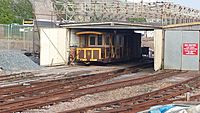 |
| 5 (1st) | 30 seat saloon | VER/Paston Place Works | 1896 | Siemens 8 hp (6.0 kW) |
Scrapped | This car was scrapped in the late 1920s. We don't know what happened to it. | |
| 5 (2nd) | 24 seater winter Car | G.Kelsey, Hove | 1930 | Siemens 8 hp (6.0 kW) |
Scrapped | This was a special enclosed car made of steel for bad weather. It was badly damaged from being stored during the war and rusted a lot. It was scrapped around 1946. | |
| 6 | 40 seat semi-open | VER/Paston Place Works | 1901 | Compagnie Electrique Belge 8 hp (6.0 kW) |
Operational | This car was fixed up and made ready to run between 2016 and 2018 with money from the Heritage Lottery. |  |
| 7 | 40 seat semi-open | VER/Paston Place Works | 1901 | Compagnie Electrique Belge 8 hp (6.0 kW) |
Operational | Cars 7 and 8 were the first ones designed with doors on the side. |  |
| 8 (1st) | 40 seat semi-open | VER/Paston Place Works | 1901 | Compagnie Electrique Belge 8 hp (6.0 kW) |
Operational | This car was numbered 5 between 1948 and 2000. |  |
| 8 (2nd) | Southend Pier 40 seat open | Falcon Works, Loughborough | 1898 (Into VER service 1950) | Two 140 Volt motors. | No longer on the railway | This car was bought from the Southend Pier Railway around 1948. It ran on the VER until the 1990s. Now it is on display at the Southend Pier Museum. | |
| 9 (1st) | 40 seat open | VER/Paston Place Works | 1910 | Compagnie Electrique Belge 8 hp (6.0 kW) |
Operational | This car was numbered 2 between 1948 and 2000. | 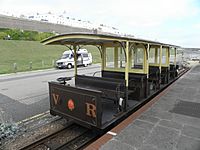 |
| 9 (2nd) | Southend Pier 40 seat open | Falcon Works, Loughborough | 1898 (Into VER service 1953) | Two 60 volt milk-float motors. | No longer on the railway | This car was bought from the Southend Pier Railway around 1948. It ran on the VER until the 1990s. Now it is on display at the South Downs Heritage Centre in Hassocks. | |
| 10 | 40 seat open | VER/Paston Place Works | 1926 | Compagnie Electrique Belge 8 hp (6.0 kW) |
Operational | This car was numbered 1 between 1948 and 2000. It was fixed up and made ready to run between 2016 and 2018 with money from the Heritage Lottery. |  |
| PW | Diesel works locomotive | Motor Rail (Alan Keef Ltd.) (40SD530) | 1988 (Into VER service 2004) | Perkins diesel engine. | Operational. | This is the first non-electric vehicle on the VER. It is used for maintenance and checks when the power rail is turned off. | 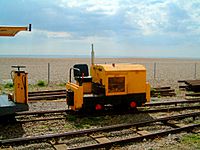 |
The railway also has some special wagons. These are used with the diesel engine for maintenance work.
A very detailed model of Volk's carriage No. 6 is on display. You can see it in the entrance area of the Brighton Toy and Model Museum. It was given by Siemens, who made much of the railway's electrical equipment.
Volk's Electric Railway Association (VERA)
The Volk's Electric Railway Association (VERA) was formed in 1995. This group supports the railway. Members of VERA help with practical tasks like operating and maintaining the trains. They also help promote the railway.
The Association often goes to exhibitions with a large model of the railway. This model shows how the railway looked in the 1950s. Anyone who is interested in the railway can join VERA. Members get a magazine every three months. They also get cheaper train rides and free entry to interesting meetings in Brighton during the winter.
VERA also collects items related to Volk's railway. Some of these items can be seen at the South Downs Heritage Centre in Hassocks. The largest item they care for is an old train car from Southend. This car was numbered 9 on the Volk's railway between 1950 and 2000.


